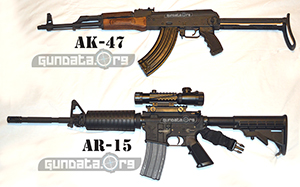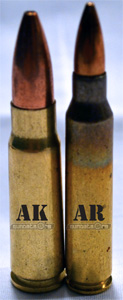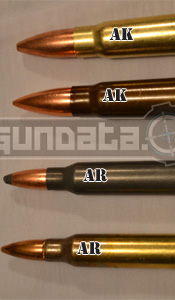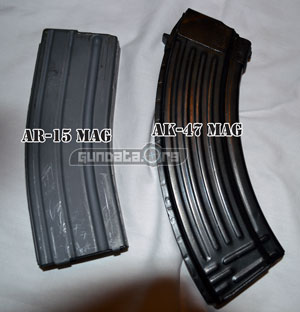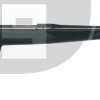AK-47 vs AR-15 History and Facts
Article Posted: August 7, 2012
This article is meant to provide raw facts, data, ballistics, and personal experiences on both the AK-47(7.62x39), and AR-15 (5.56x45mm) in an effort to provide a "foundation" of knowledge. There is again so much disinformation out there that GunData.org wants to provide "hard" and "reliable" data. Please like, share, and tweet this article in any way possible.
The Birth of the Modern Day Assault Rifle
The age of the first true successful assault rifle started to come into play during the end of World War II. The Nazi Germans were producing weapon technology that was more advanced in almost every fashion than any other country in the world at the time. One such weapon was the "Storm (assault) Rifle" known as the StG 44 (Sturmgewehr 44), which had the ability to suppress enemies under fire with out the previous two-man machine gun method. This enabled one soldier with a StG 44 to be able to pin down another group of forces under suppressive fire, while other soldiers could maneuver around to get a better advantage to overtake a force they were fighting. While other gas-operated self reloading rifles such as the MAS-40 were used earlier during World War II, the StG 44 is considered by many historians as the first true modern assault rifle.
The StG 44 had a spring loaded magazine capable of holding up to 30 rounds of 7.92x33mm Kurz cartridges. The detachable magazine was curved and rounds were fed through a tilt-action bolt design that recoiled from a gas-operated piston which auto-reloaded the chamber after each shot was fired. After the defeat of the Nazi Germans, countries including the United States and Soviet Russia began to create their own variations based off the "Storm Rifle" concept with different functional designs on the inner parts. This paved the way for the creation of both of the most well-known assault rifle designers in the Eastern and Western hemisphere, Mikhail Kalashnikov and Eugene Stoner to become two of the most successful individual firearms designers of the 20th century.
AK-47 History
The AK-47 is one of the first assault rifles that were produced after World War II ended in Europe. In 1938 Mikhail Kalashnikov was drafted into the Red Army as a T-34 tank driver. In 1941, during the battle of Bryansk, Senior Sgt. Kalashnikov was injured during the 19 day fighting period. He was able to make it to a hospital on foot to seek treatment for his wound.
At some point, after frequent flashbacks during his hospital admittance, Kalashnikov gained his inspiration for the most successful assault rifle of modern times. Kalashnikov started experiencing flashbacks of the previous battles raids, which in turn started to overwhelm him and he "became obsessed with creating a submachine gun that would drive the Germans from his homeland." He then entered a contest for a gun competition to create a better rifle for the 7.62x41mm rifle round. At the time his proposal was rejected, but it was enough to get him on the newly formed team of rifle designers for further work on designing a modern rifle for the Red Army.
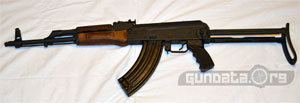 During his work trying to build a better rifle for the Red Army, Russian designer Mikhail Kalashnikov designed the gas operated carbine for the 7.62x39mm cartridge in 1944. After trials with the previous AK-46 model, in 1947 Kalashnikov created the stock version AK-47 (which stands for Avtomat Kalashnikova.) This newer design was eventually accepted in 1949 as the standard Soviet rifle due to its superb functional design. The AK-47 is known for its wood-stock finish on the butt, grip, and barrel that makes it easy to recognize over other firearm models.
During his work trying to build a better rifle for the Red Army, Russian designer Mikhail Kalashnikov designed the gas operated carbine for the 7.62x39mm cartridge in 1944. After trials with the previous AK-46 model, in 1947 Kalashnikov created the stock version AK-47 (which stands for Avtomat Kalashnikova.) This newer design was eventually accepted in 1949 as the standard Soviet rifle due to its superb functional design. The AK-47 is known for its wood-stock finish on the butt, grip, and barrel that makes it easy to recognize over other firearm models.
Long-Stroke Piston
The design behind gas-operated reloading is to provide energy from the high pressure gas that is released for the next cartridge to load after the previous round has been fired. This enables a consistent flow of action for magazines to spend all their cartridge casings. The AK-47 Model is designed off of a long-stroke piston model, which has a larger piston to help add force to the extraction, chambering, and locking of the next round. The AK-47 is known for being able to fire in harsh environments, even if they are not well-kept, partly due to the gas from each round that is fired is not directed back into the chamber to help keep carbon and dust particles from clogging it up to reduce the likelihood of jams.
Kalashnikov AK-47 Specifications
AK-47 Operation:
- Action: Gas-Operated, Rotating Bolt
- Cartridge: 7.62x39mm
- Feed System: 30 round detachable box magazine
- Muzzle Velocity: 2,330 feet per second (710 m/sec)
- Cyclic Rate of Fire: 775 rounds per-minute
- Maximum Effective Distance: 984 Feet, 300 m
- Sight: Adjustable Iron Sight
Operating Cycle
Firing the AK-47 consists of loading the magazine into the chamber, pulling on the charging handle to insert the first round, and firing the weapon. The AK-47 has a semi-automatic cycle where the operator has to pull on the trigger after each round is fired to fire off a new round, or in automatic cycle it can unload all the magazine rounds through the chamber until it is empty with one trigger pull.
7.62x39mm Ballistics

The 7.62x39mm cartridge was designed by the Soviet Russians in 1943 during World War II. The specifications off Wolf Ammo, Clear.Net.NZ, and Seller & Bellot are as follows:
- Case type: Rimless, bottleneck
- Bullet diameter: 7.92 mm (0.312 in)
- Neck diameter: 8.60 mm (0.339 in)
- Shoulder diameter: 10.07 mm (0.396 in)
- Base diameter: 11.35 mm (0.447 in)
- Rim diameter: 11.35 mm (0.447 in)
- Rim thickness: 1.50 mm (0.059 in)
- Case length: 38.70 mm (1.524 in)
- Overall length:56.00 mm (2.205 in)
- Case capacity: 2.31 cm³ (36 gr H2O)
- Rifling twist: 240 mm (1 in 9.45 in)
- Primer type: Boxer Large Rifle
- Maximum pressure: 355.00 MPa (51,488 psi)
- Filling: SSNF 50 powder
- Filling weight: 18.21 gr
Ballistic performance
| Bullet weight/type /th> | Velocity | Energy |
|---|---|---|
| 123 gr (8.0 g) Full metal jacket | 731.5 m/s (2,400 ft/s) | 2,073.6 J (1,529.4 ft lbf) |
| 154 gr (10.0 g) Spitzer SP | 641.3 m/s (2,104 ft/s) | 2,056.3 J (1,516.6 ft lbf) |
| 123.5 gr (8.00 g) Full metal jacket | 804.7 m/s (2,640 ft/s) | 2,460 J (1,810 ft lbf) |
| 123 gr (8.0 g) Full metal jacket | 738 m/s (2,420 ft/s) |
Gun Data 7.62x39mm Chart
Gun Data chart on range/drop of the 7.62x39mm Russian, American Eagle (Federal) Full Metal Jacket 124, gr under normal settings.
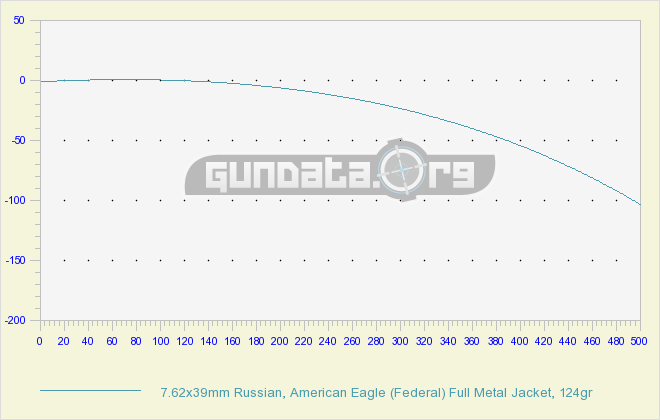
 Create Your Free Custom Ballistic Report
Create Your Free Custom Ballistic Report
Model Variations
- 1948-51: first version of the AK-47
- 1952: The famous wood, grip, and barrel AK-47 design
- RPK: Handheld machine gun version
- AKM and AKMS: Lighter version of the AK-47 with a folding stock on the AKMS versio
- Saiga Series: A Civilian hunting version of the AK-47 rifle that also has a hybrid semi-automatic shotgun version
Hunting and Sport Uses
After a failed introduction in the 1970's, the Saiga series was reintroduced in the 1990's by Izhmash that feature the same model design in different caliber versions ranging from .223, 30-08, up to 7.62x39mm cartridges. The Saiga series uses the same gas-operated design as the AK-47, and is known for having less carbon build up to prevent jams while firing.
AR-15 History
 Eugene Stoner is credited as being one of the most successful firearms designers of the 20th Century along side John Browning, and John Garand. Stoner became the chief engineer of the Armalite division Fairchild Engine and Airplane Corporation in 1954 after previously working as the design engineer for Whittaker. He began testing firearm models that included the AR-3, AR-9, AR-11, and AR-12. None of these models saw any real progress until the AR-10 design was made. In 1956, Stoner submitted the AR-10 for a late entry into the U.S. Army Aberdeen Proving Ground test trials. The late entry wasn't enough to convince the Army to change its mind on going ahead with the T44 instead, but did a get license for a Dutch manufacturer to produce the weapon.
Eugene Stoner is credited as being one of the most successful firearms designers of the 20th Century along side John Browning, and John Garand. Stoner became the chief engineer of the Armalite division Fairchild Engine and Airplane Corporation in 1954 after previously working as the design engineer for Whittaker. He began testing firearm models that included the AR-3, AR-9, AR-11, and AR-12. None of these models saw any real progress until the AR-10 design was made. In 1956, Stoner submitted the AR-10 for a late entry into the U.S. Army Aberdeen Proving Ground test trials. The late entry wasn't enough to convince the Army to change its mind on going ahead with the T44 instead, but did a get license for a Dutch manufacturer to produce the weapon.
Afterwards the U.S. Army requested Stoner and his team complete a redesign of the AR-10 for testing to see if it fit their model for a lighter weight weapon. The result was the semi-automatic gas-operated AR-15 (also known as the M16) rifle. The NATO 5.56x45mm (derived from the .223 round) was also developed for use with the AR-15 as a redesign of the .223 caliber cartridge.
Direct Gas Impingement
The first successful direct impingement rifle was the MAS-40 (1940) produced in France by Manufacture d'armes de Saint-Etienne (MAS) for use in World War II. The more modern MAS-49 design was taken as an example from the MAS series of weapons by Eugene Stoner and implemented in the AR-15 model. Direct gas-operated impingement design has high-pressure gas that directly routes and forces the piston into the bolt to reload the chamber after each round is fired. The reason behind this is to cut down on weight from adding an extra gas cylinder, piston, and rod that is separate. The light weight design is what helped make the M16 the set standard for the U.S. Army. The reduced design that lowered the weight restrictions from the AR-10 on the AR-15 also caused it to have significant problems with jamming after being fired in the field due to carbon build-up and the smaller barrel redesign from the AR-10.
AR-15 Specifications
AR-15 Operation:
- Action: .Gas-operated Direct impingement design with a rotating bolt
- Cartridge: 223 Remington, 5.56x45 NATO Round
- Feed System: 20-30 Round detachable magazines or 40-50 round box magazines
- Muzzle Velocity: 3,200 feet per second (975 m/sec)
- Cyclic Rate of Fire: Up to 800 rounds per-minute on full-auto versions
- Maximum Effective Distance: 400 to 600 meters
- Sight: Adjustable Front Iron Sight and rear day/night iron sights
- Weight: 2.27 kg-3.9 kg (5.5-8.5 lb)
- Magazine: STANAG design which was adopted for use by NATO in the early 1980's after the introduction of the 5.56x45mm cartridge.
Barrel length for various models
- 24 in (610mm)
- 20 in (508 mm) standard
- 18 in (457 mm)
- 16 in (406 mm)
- 14.5 in (368 mm)
- 11.5 in (292 mm)
- 7 in (178 mm)
- 6.5 in (165mm)
AR-15 Operating Cycle
Firing the AR-15/M16a2 consists of loading the magazine into the chamber, pulling on the charging bolt to insert the first round, and firing the weapon. The M16a2 has a selection switch to enable semi-automatic cycle where the operator has to pull on the trigger after each round is fired to fire off a new round, or in automatic cycle it can fire off 3 round bursts per trigger action until all the magazine rounds through the chamber until the magazine is empty.
5.56x45mm Ballistics
.png)
The AR-15 cartridges are designed from the .223 Remington case and ballistics information is taken from the 5.56x45mm NATO design by NATO EPVAT testing, which is one of the three recognized classes of testing methods used to determine the quality of firearm ammunition.
Parent case: .223 Remington Sporting Cartridges
- Case type: Rimless, bottleneck
- Bullet diameter: 5.70 mm (0.224 in)
- Neck diameter: 6.43 mm (0.253 in)
- Shoulder diameter: 9.00 mm (0.354 in)
- Base diameter: 9.58 mm (0.377 in)
- Rim diameter: 9.60 mm (0.378 in)
- Rim thickness: 1.14 mm (0.045 in)
- Case length: 44.70 mm (1.760 in)
- Overall length: 57.40 mm (2.260 in)
- Case capacity: 1.85 cm³ (29 gr H2O)
- Rifling twist: 178 mm or 229 mm (1 in 7 in or 9 in, originally 1 in 14 in)
- Primer type: Small rifle
- Maximum pressure: 430.00 MPa (62,366 psi)
Full Metal Jacket Boat Tail (FMJBT)
| Bullet weight/type | Velocity | Energy |
|---|---|---|
| 4 g (62 gr) SS109 FMJBT | 940 m/s (3,100 ft/s) | 1,767 J (1,303 ft lbf) |
| 4.1 g (63 gr) GP 90 FMJBT | 905 m/s (2,970 ft/s) | 1,679 J (1,238 ft lbf) |
| 123.5 gr (8.00 g) Full metal jacket | 804.7 m/s (2,640 ft/s) | 2,460 J (1,810 ft lbf) |
Gun Data (5.56x45mm/.223 Rem) Chart
Gun Data chart on range/drop for .223 Remington, American Eagle (Federal) Full Metal Jacket, 62 gr
-fmj-62gr.png)
 Create Your Free Custom Ballistic Report
Create Your Free Custom Ballistic Report
Model Variations
The AR-15 carbine comes in a wide-variety of model designs. This includes but is not limited to manufacturers such as ArmaLite, Colt, Double Star, Rock River, and DPMS Panther Arms. The model designs, upgrade options, along with parts & accessories can help make for an easy custom AR-15 design.
Hunting and Sport Uses
The AR-15 is widely used by hunting varmints or medium-sized game, and sport enthusiasts for target practice. The AR-15 has a large assortment of customizable designs that make it a popular rifle to own, and it is easy to strip down for cleaning after it has been fired.
Personal Experience
I spent slightly under 10 years in the Army Reserves, seven of which was in a Charlie Company medical unit that was attached to a forward support battalion in Iraq during OIF III (2004-2005.) My main role was providing medical support on convoy supply missions from the main FOB in our AO (Northern AO, Kirkuk area) to smaller out-lying FOBs while driving around in my ambulance. I did how ever also get to work as a medic in the prison at various FOBs, was sent out as a substitute medic to fill in for infantry medics who were gone on their 2 week leave, and various other tasks. Basically, everything a medic can do except fly on Blackhawks.
As far as firing the AK-47 goes, I never had the opportunity to fire one as of yet. The AK-47 was the rifle pretty much every single person in Iraq owned. They mainly used it to shoot up in the air when they were excited, or having a family party at night. Most of the attacks I experienced were mainly through explosive devices such as IED's or RPG's. So, the majority of my experience is based off of treating wounds from either explosions or normal health issues when soldiers were sick.
However, they did love to do a method we called "spray and pray"; where basically they hide behind a wall, lift the AK-47 over it with out looking, and take a few shots then run off hoping they hit something. We had once instance where someone took a few pot-shots at us and a soldier in a mortar platoon was separated from the rest of us to go to the bathroom for a minute. One of the bullets hit his right arm just above the bicep and passed all the way through the soft-tissue with out damaging any bone or major vessels. Surprisingly, the damage was minimal, and after about 8 days wearing an arm sling he was able to take it off, and about 4 weeks later he had full range-of-motion to include strength back in his arm.
The M16a2 on the other hand, was the weapon I was issued my entire time in the military. I know a lot of people complain about how it can jam up on them, but I never had a serious issue with mine. The original M16 (which I never fired) was apparently a horrible weapon when it came to jams. The one I used only jammed on me three or four times ever during the years I used them.
I was never involved in any major battles like Fallujah or taking care of the Sunni-Triangle, but we did get in a few 30 to 60 second long skirmish fire-fights with people (which were usually handled by the .50 cal turret-gunners on the vehicles in the convoy.) I can say with proper training the M16a2 is more accurate when it comes to firing along with controlling the pulling from firing, but the AK-47 can be dragged through sand, kicked around and still be able to fire with out jamming.
Contributing Author: Jason Brumett
Articles Worth Reading
Related Articles
- 3 Good 300 AAC Blackout Reviews
- 30-06 vs. 270 Win
- How to Sight in a Scope - Step by Step Guide
- Joe Biden Toilet Paper
- Bushcraft 101
- Best Ammo Boxes
- Advertise
Please like, share, favorite, bookmark, and comment. Thank You.
Main Menu
Original Articles
- New 25+1 Capacity Shotgun!
- Hudson H9 American Made 9mm
- How To Build A Mud Hut
- Pistol Looks Like Cell Phone
- 45 ACP vs 9mm Luger
- Best 9mm Carbines
- Mall Ninja Xtreme Zombie Carbine!
- 5 Alternative Range Bags for Pistols
- Best 45 ACP Carbines
- 5 Dirt Cheap Guns $170 to $260
- Muslim Free Shooting Range?
- How To Clean A Rifle
- 3 Good 300 AAC Blackout Reviews
- Top 5 Guns for Women
- How to Really Shoot A Pistol
- Worlds Best 9mm Handgun
- 5 Great Gun Safes (Options)
- 9mm vs 40 S&W Summary + Ballistics
- Red Oak, White, or Chestnut for Deer Herd?
- Bullets for Barter Post Collapse
- Funny Pro Gun Sayings
- 5 Strange Handguns You Don't Need
- 3 Great .22LR / 410 Survival Rifles
- American Rifles | The Original ARs
- 600 Round Glock Magazine
- 10mm vs 40 Summary and Ballistics
- How Important is "Shot Placement"?
- 10 Item First Aid Kit Checklist
- 10 Gun Lights for Home Defense
- How to Make a Stove Hobo Style!
- Most Basic Survival Food List Ever
- Best Handguns for Women
- Make Homemade Mosquito Trap
- Lets make a Sawed-Off Shotgun!
- Man Brings Knife to Gun Fight (Funny)
- Gun Store Etiquette (Proper vs Improper)
- 10 Simple Home Security Tips
- SIG-Sauer vs Glock
- Legal Length of Shotguns and Rifles
- 9mm Pocket Pistols
- Glock 17/19/26 Operating Procedures
- 10 Conceal Carry Tips (Funny)
- Understanding the 2nd Amendment
- Choose Your Own Crime Stats
- After You Dial 911 : Dont Be A Victim
- Does Gun Control Work?
- Best Shotgun Ammo for Self Defense
- Best Calibers for Self Defense
- FBI Handgun Ballistics
- 38 Special vs 380 ACP
- Top 5 Home Defense Handguns
- 5 Best Home Defense Shotguns
- How to Sight in a Scope - Step by Step Guide
- .380 ACPs Stopping Power (Funny)
- AK-47 vs AR-15 History and Facts
- A Bug Out Bag Checklist for 2015
- 30-06 vs. 270 Win
- Gun Stores
Ballistics Tools & Data
- Ballistic Trajectory Calculator
- Ballistic Coefficient Calculator
- 9mm Ballistics Chart
- 308 Ballistics Chart
- 30-06 Ballistics Chart
- .270 Win Ballistics Chart
- 30-30 Ballistics Chart
- 7.62x39mm Ballistics Chart
- 7mm Rem Magnum Ballistics Chart
- 17 HMR Ballistics Chart
- 223 Ballistics Chart
- .243 Ballistics Chart
- 22-250 Ballistics Chart
- Convert FPS to MPH

